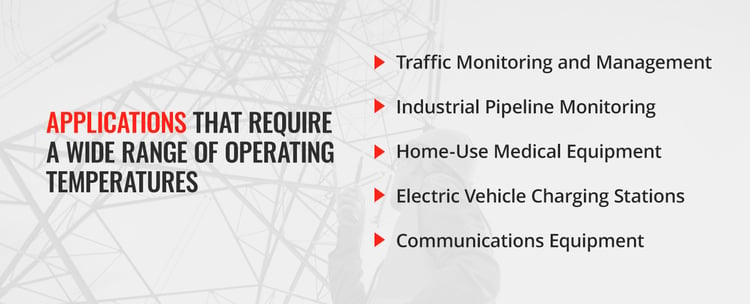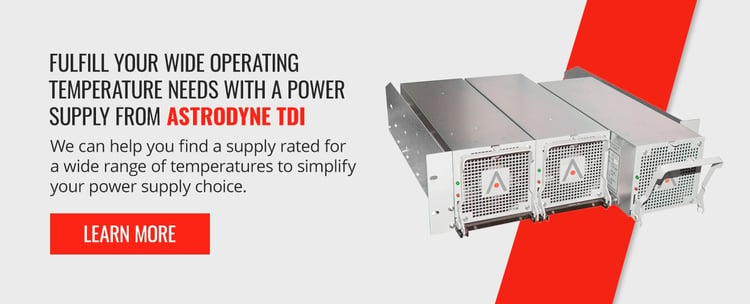RESOURCES
The Benefits of Wide Operating Temperature Power Supplies
When you're selecting a power supply for your system, you'll need to consider its ambient operating temperature range. Running your power supply within its specified operating temperatures are essential for optimizing its performance, preventing overheating and breakdowns, and extending its lifespan.
Choosing a power supply with a wide operating temperature range can provide many advantages, especially for applications in demanding environments, such as outdoors, in sealed enclosures, and in other situations that experience more extreme temperatures or have limited cooling options. Depending on the application, a power supply with a wide operating temperature range may provide better reliability and a longer operating lifetime, prevent the need for a cooling fan or other special design consideration for thermal management, and reduce the overall cost of your system.
Typical and Extended Operating Temperatures
Typical commercial power supplies are specified to support their full rated load over an ambient temperature range from zero or minus 25 degrees Celsius to around 50 degrees Celsius, and they may derate to 50% load at 70 degrees Celsius. They are designed using widely available standard components to address a subset of applications with relatively benign environments. Some applications may require ambient operating temperatures as low as -40 degrees Celsius and as high as +85 degrees Celsius, or an even wider range.
Factors that Affect Ambient Temperatures in an Application
A number of factors can influence the ambient temperature that a power supply is subjected to in a given application, including the following:
- Overall ambient temperature in the application’s environment
- The system enclosure, and whether it is vented or sealed
- Self-heating of the power supply, due to its load
- External radiant heating, such as solar heating in an outdoor application
- Nearby equipment and other sources of heat
Self-heating of the power supply is an often overlooked consideration. An inefficient power supply will generate more heat because not all energy from its input can be transferred to usable electric energy at its output. The portion that cannot be transferred is converted to heat, which increases the ambient temperature around the power supply. For this reason, it is also important to select a power supply with a high-efficiency rating, generally greater than 90%.
Consequences of Exceeding Power Supply Operating Temperature
Exceeding standard operating temperatures means running your power supply when the ambient temperature falls outside the operating temperatures for which it is rated. Sometimes this happens — you can't predict every possible usage scenario, and you can’t always guarantee a stable environment.
Power supply degradation, malfunctions, or failures can occur if ambient temperatures around the power supply are outside of the specified operating range:
High temperatures: An excessively high operating temperature for a power supply can reduce its lifetime. This type of degradation may not present itself in any observable manner until the power supply simply ceases to operate after being used a certain number of hours. Occasional operation at temperatures modestly higher than the specified limits may not lead to any appreciable difference in lifetime, but the longer a power supply is operated this way, the shorter the lifetime will be in general, due to stresses induced on the various components in the design. Higher quality and higher-rated components can both increase lifetime and limit the impact of occasional high temperature excursions, and reducing the load of the power supply in such instances can also minimize the amount of degradation. In the case of extremely high-temperature excursions - for even a brief period-specific malfunctions or outright failures can occur quickly, often due to individual component malfunctions or breakdowns incurred by the high temperature.
Low temperatures: Reduced lifetime of product failure from low operating temperature is rare, except in the most extreme cold conditions. More likely, cold temperatures will result in performance limitations, such as increased voltage ripple, an inability to fully regulate the output, or an inability to start up. In extreme cold, and especially when stored that way for a long time, the seals on the electrolytic capacitors in the power supply can fail. Such a failure is catastrophic for the component and will result in non-operation or out-of-spec performance of the power supply.
Applications that Require a Wide Range of Operating Temperatures
Below are a few applications that typically require a wider range of operating temperatures for optimal performance and safety.
Traffic Monitoring and Management
In traffic monitoring and management applications, the equipment is located in sheltered outdoor enclosures, in fluctuating temperatures — scorching in summer and freezing in winter. Traffic management equipment that has power supplies with wide operating temperatures will function more reliably and help maintain public safety in all weather.
Industrial Pipeline Monitoring
Industrial pipelines also run outdoors in unregulated temperatures, so monitoring equipment may be subject to a range of hot or freezing temperatures depending on the pipeline's location. Monitoring equipment with a power supply that can operate in a range of temperatures will help detect leaks and protect the environment even during extremely hot or cold weather.
Home-Use Medical Equipment
With home-use medical equipment such as dialysis machines, the enclosure may be sealed for operator safety, so a lack of air exchange limits the methods that can be used to cool the power supply. Although an internal fan can help reduce the impact of localized heating, it cannot bring down the overall temperature within the enclosure. For these reasons, home-use medical equipment may require a power supply that can provide reliable operation in ambient temperatures up to 85 degrees Celsius.
ELECTRIC VEHICLE CHARGING STATIONS
Electric vehicle charging stations operate outdoors in extreme, uncontrolled temperatures. To maintain optimal performance and allow people to recharge their cars without worrying they'll become stranded in very hot or cold weather, electric charging stations should have a wide operating temperature power supply.
Communications Equipment
Communications equipment often requires a ruggedized enclosure that does not always allow for adequate ventilation. Additionally, the equipment is often installed on exposed poles outdoors, where it may bake in the hot sun. Higher operating temperatures are essential in these scenarios to keep communications equipment functioning properly.
Considerations for Power Supply Selection in Applications with Wide Operating Temperatures
Below are a few things to keep in mind when selecting power supplies for applications with wide operating temperatures. These considerations will help you identify a power supply that runs effectively and reliably in your system.
Output Power Ratings and Operating Temperature
The rated output power of a power supply is valid over a particular set of conditions, including its input voltage, the ambient temperature around it, and the method of cooling employed. The power rating applies over a specific range of operating temperatures and is often derated under some of this range (typically at higher temperatures.) Under equivalent operating conditions, a power supply that has a wider operating temperature range and less derating limitations will have a longer life than one with a more narrow range or more derating.
Cooling Method (Convection, Forced Air, Conduction)
The power rating for each power supply is based on specific cooling methods. Convection cooling is the most prevalent for commercial supplies, and means that the unit requires free air exchange, but no specific airflow across it. (Note that a sealed environment is typically not considered a convection situation.) Some power supplies specify forced air cooling, provided by either an external fan or one embedded in the supply itself. It is important to provide the specified volume and direction of airflow, in order to cool the supply properly. Conduction cooling may be required in situations where air exchange or forced airflow is not available. In conduction cooling, heat is transferred away from the power supply using a heat sink or thermal plate attached to the frame or housing of the supply. Not all power supplies are designed to support all cooling methods, so it is important to choose a supply that works with a cooling method available in your system. At Astrodyne TDI, we can help you weigh the pros and cons and make a decision that will work best for your power solution.
Size
The size of a power supply is generally correlated with its power rating and operating temperature range. Larger supplies are required to accommodate higher power ratings, and the smaller a supply is, the more likely it is to require aggressive cooling methods to support higher output powers. Component selection and efficient thermal design methods are critical facets of a power supply design that can enable smaller solutions with higher output powers, using less costly cooling methods. The team at Astrodyne TDI can guide you to the optimal power supply for your power solution.
Efficiency
A more efficient power supply will produce less heat, simplifying the thermal management of its design. This means that a power supply with a wide operating temperature range is likely to have a high-efficiency rating as well. Power supplied with lower efficiencies are more likely to require aggressive cooling methods to maintain their reliability at higher ambient operating temperatures.
Touch Temperature (Primarily a Concern for External Power Supplies)
In applications where a user or operator can come in contact with the power supply, the touch temperature of the supply should remain low enough that it won't cause injury. Proper thermal design of the power supply will mitigate this risk, and supplies with wider operating temperatures ranges are likely to exhibit less temperature rise, resulting in lower touch temperatures for a given ambient operating temperature.
Fulfill Your Wide Operating Temperature Needs with a Power Supply from Astrodyne TDI
Now that we've discussed the characteristics and benefits of wide operating temperature power supplies, why not see their advantages for yourself? To gain the benefits of a power supply rated for a wide range of operating temperatures, work with Astrodyne TDI. The Astrodyne TDI team are expert at testing and certifying power supplies over an extensive range of temperatures. We can simplify your power supply choice by helping you find the best power solution that meets the needs of your system.
Contact us today to learn more.

